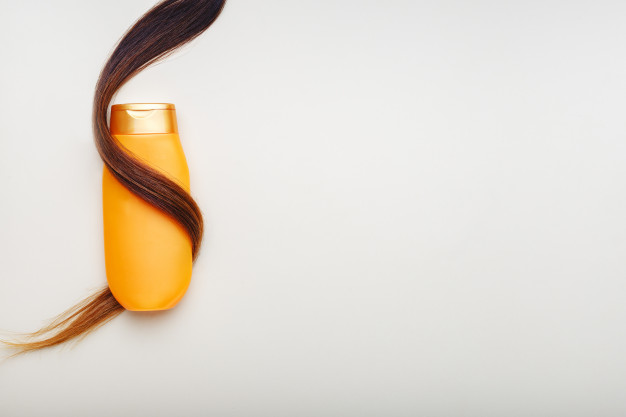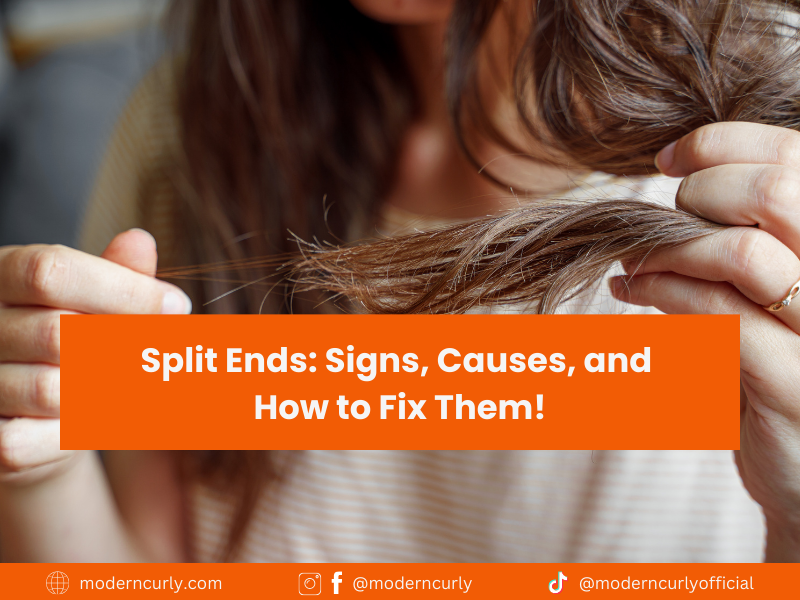Split ends can be frustrating, especially when you’re trying to keep your hair looking healthy and vibrant. Everyone experiences them at some point, whether due to everyday styling or environmental factors. The best way to manage split ends is by trimming them regularly and using nourishing haircare products. Frequent trims prevent the problem from worsening and help maintain your hair’s health.
What Are Split Ends?
Split ends happen when the tips of your hair become dry, fragile, and split into two or more strands. They are a common hair problem, especially if you use heat styling tools, chemical treatments, or don’t use conditioners regularly.
Read Also: The Hair Struggles Every Guy Faces (and Hates)
The main cause of split ends is damage to the outer layer of your hair. When the protective layer is worn away, the inner core of your hair becomes exposed and starts splitting.
Do split ends stop hair growth?
Split ends are a common hair problem that many people face. They occur when the protective outer layer of the hair gets damaged, causing the ends to fray. While split ends can make hair look dull and damaged, they don’t stop your hair from growing at the root. These are how split ends affect hair:
- Hair appears thinner.
- Makes hair prone to breakage.
- Gives a rough texture and feel.
Getting regular trims is the most effective way to manage split ends. Eliminating damaged ends can make your hair look healthier and prevent further splitting. Regular trims every 6 to 8 weeks can keep your hair looking its best.
Common Signs of Split Ends
- Frayed tips: Your hair may feel rough or look uneven at the ends.
- Knotted strands: You might notice more tangles near the ends.
- Dull appearance: Your hair can lose its natural shine.
To help protect your hair from split ends, try these tips:
- Use a wide-tooth comb: It reduces breakage.
- Avoid excess heat: Limit the use of hair dryers or straighteners.
- Trim regularly: Get a haircut every 6-8 weeks.
Fun Fact!
Did you know that ancient Egyptians were among the first to use oils to condition their hair? Even Cleopatra might have had her own DIY tricks to avoid splitting hair!
Taking care of your hair helps maintain its health. Treat your hair with kindness. Enjoy shampoos and conditioners that nourish and strengthen. Your vibrant, healthy hair awaits!
What Do Split Ends Look Like?
Split ends can appear in various forms, affecting the appearance and health of your hair. Recognizing the different types helps in taking the right steps to minimize damage and keep your hair looking splendid.

Double Split
A Double Split occurs when a single hair strand splits into two separate ends, resembling a fork. It’s more noticeable and easier to feel when you run your fingers through your hair. This kind of split indicates that the hair has been weakened over time, usually due to excessive styling, heat, or lack of moisture. Generally, regular trims can help manage this, along with proper conditioning that keeps your hair hydrated and resilient against future damage. To avoid double splits, consider using heat protection sprays and embracing gentler hair care practices.
Partial Split
A Partial Split refers to a situation where the hair strand doesn’t completely split into two sections but shows a weak point along the shaft where damage is starting. These are harder to spot because they may not be visible at the ends. You might notice a rough texture or weak point when running a comb through your hair. Address these with nourishing masks and regular care to strengthen and prevent further splitting. Paying attention to early signs can help in maintaining smooth and shiny hair, ensuring it remains healthy and vibrant.
Tree Split
A Tree Split describes a hair fiber that has multiple small splits branching out from a single point along the strand. This type often resembles a tree with many branches. Frequent styling with heated tools or exposure to harsh chemicals can cause this. You’ll likely experience frizz and tangling, making your hair difficult to manage. Deep conditioning treatments and minimizing heat application are essential steps to combat tree splits. Adopt a hair regimen that includes using wide-tooth combs to gently detangle and avoid unnecessary breakage.
Fork Split
The Fork Split is similar to the double split but features additional tiny splits off the main split ends, like a fork with more prongs. This indicates that the hair is in a fragile state. Often resulting from prolonged neglect or severe environmental damage, it requires immediate action to prevent breakage. Regular trims combined with protective styles can help keep the hair ends sealed and neat. Embrace protective hairstyles that reduce manipulation and limit the use of tight accessories to save your strands from further stress.
What Causes Split Ends?

Split ends occur when the ends of your hair become dry and brittle, often due to external damage. Factors like heat styling, chemical treatments, and environmental exposure all contribute to this common issue. Let’s explore the main causes, including lifestyle habits and natural factors.
Read Also: Frizz Fix! Game-Changing Hacks for Dry Hair!
1. Excessive Heat

Using tools like straighteners, curling irons, and blow dryers frequently can lead to split ends. The intense heat removes moisture from your hair, making it dry and more prone to breakage. Try using a heat protectant and lower heat settings to reduce damage. Limiting heat styling to a few times a week can also give your hair time to recover naturally.
2. Chemical Treatments
Procedures such as coloring, perming, or relaxing can weaken the hair shaft. Chemicals break down the protective outer layer, leaving hair susceptible to split ends. If you enjoy experimenting with your hair, choose gentle products or seek professional advice. Spacing out treatments can also help maintain healthier strands, giving them time to strengthen.
3. Over Washing
Frequent washing can strip your hair of its natural oils, leading to dryness. It’s tempting to keep it clean, but overwashing affects the hair’s moisture balance. Try washing your hair only a few times a week. Opt for a sulfate-free shampoo to maintain natural oils, and consider using a lightweight conditioner for moisturizing.
4. Rough Brushing
Brushing your hair aggressively, especially when wet, weakens the strands and causes split ends. Invest in a wide-tooth comb or a brush designed for wet hair. Detangle slowly and gently, starting from the ends moving upwards. This method prevents unnecessary tension and breakage, keeping your hair happier and healthier. Also, just to keep it in mind, having curly hair means that you are going to need special comb and brush to take care of them.
5. Environmental Factors
Exposure to sun, wind, and pollution can lead to split ends by wearing down hair cuticles. When you’re outside, especially on a sunny day, use a leave-in conditioner with UV protection. Wearing a hat or scarf can also minimize exposure. These small actions protect your hair from the environment’s harsh effects.
6. Skipping Trims
Avoiding regular trims is a common mistake that allows split ends to worsen. Cutting off the damaged ends every 6-8 weeks helps maintain overall hair health. If you notice your hair feels rough or appears frizzy, a quick trim could make a big difference. It encourages growth by focusing on healthy strands.
7. Poor Diet
A diet lacking in essential nutrients affects your hair’s integrity, leading to more frequent split ends. Ensure your meals include foods rich in vitamins, proteins, and healthy fats. Examples include fish, nuts, leafy greens, and fruits. Proper nutrition keeps your hair strong and resilient from the inside out.
8. Genetics and Ageing
Sometimes, split ends result from genetics and aging. As you grow older, your hair’s natural oil production decreases, leading to dryness and brittleness. Embrace your hair’s natural texture and thickness. Using restorative hair masks or treatments can help combat age-related issues, nourishing your hair and enhancing its shine.
How To Handle Your Split Ends?

Split ends can be frustrating, but tackling them is totally doable. The following tips can help you keep your hair healthier and looking fabulous.
1. Regular Trims
Snip off split ends regularly. Aim for a trim every 6 to 8 weeks. This keeps your hair looking neat and prevents splits from moving further up the strand.
2. Gentle Hair Care
Brushing your hair gently is key to avoiding split ends. Always start from the tips and slowly move up to avoid pulling and breaking. Use a wide-tooth comb or a paddle brush with soft bristles. When your hair is wet, it’s more fragile. Be gentle and avoid tugging. You can apply a detangler to make this smoother. Brushing your hair with care leads to shinier and healthier hair. Remember, patience is your best tool!
3. Heat Protection
Before using a blow dryer, curling iron, or straightener, protect your hair. Use heat protectant sprays or serums that shield hair from damage caused by high temperatures. Heat styling can cause split ends if you don’t take precautions. Always apply a high-quality heat protectant product on your hair before using hot tools like flat irons or blow dryers.
Heat protectants create a barrier, reducing damage. Use tools with adjustable temperature settings and keep the heat on low to medium. Though it might take a bit longer, it’ll help your hair stay healthy. Protecting your hair from excessive heat is vital for preventing split ends.
4. Hydrate Your Hair
Hydration is key. Use leave-in conditioners or hair oils to keep your hair moisturized. Products with ingredients like argan oil or coconut oil add much-needed moisture, making your hair smooth and soft. These products seal split ends temporarily, giving your hair a polished look. Apply the hydrating products to the ends of your hair. Consistent use keeps split ends at bay and makes your locks silky. Integrated hydrating products into your routine give life to your hair.
5. Use A Repairing Shampoo And Conditioner
Select shampoos and conditioners designed for damaged hair. Look for products that include keratin or biotin. They strengthen hair from the inside out, reducing the risk of split ends.
Use these products regularly to maintain healthier hair. Sulfate-free options are better since they are gentler and less drying. Rinsing with cold water can also help seal the hair cuticle. By picking the right products, you keep your hair robust and minimize split ends.
6. Use A Hair Mask Every Week
A weekly hair mask can work wonders. Hair masks provide deep conditioning that your regular conditioner might miss. Choose masks containing nourishing ingredients like avocado or honey for added moisture and strength. After applying, cover your hair with a shower cap and let it sit for the recommended time. Rinsing out the mask reveals softer, more resilient hair. Consistency matters, so make it a part of your weekly self-care routine to combat split ends effectively.
7. Protect Your Hair While You Sleep
Nighttime is perfect for protecting your hair. Use a silk or satin pillowcase—it reduces friction and prevents breakage. You can also wrap your hair in a silk scarf or bonnet.
Before bed, apply a light leave-in conditioner. It keeps your hair hydrated overnight. Avoid tight hairstyles that cause stress on your strands. By taking these simple steps, your hair stays smooth, reducing the chance of split ends while you sleep.
8. Healthy Hair Habits
Avoid tight hairstyles that can stress your hair. Try loose braids or buns. When swimming, use a swim cap or rinse hair before and after exposure to chlorinated water.
9. Treat Your Hair with Care
Sleeping on a silk pillowcase reduces friction and can prevent more split ends.
When towel drying, gently pat your hair instead of rubbing it harshly.
10. Eat Well
Drink plenty of water and eat a balanced diet rich in vitamins and minerals to support hair health. Foods like nuts, leafy greens, and fish can provide essential nutrients.
By following these steps, you can manage and reduce split ends effectively. Your hair can look and feel healthier, making it easier for you to rock any style with confidence!
Bonus: Best Hair Care Ingredients for Split Ends

To hide split ends, using natural oils like sweet almond oil and argan oil can help, along with using hair care products containing panthenol. These ingredients smooth and protect hair, making split ends less noticeable.
1. Sweet Almond Oil
Sweet almond oil is packed with vitamins like E, which strengthens your hair and gives it a shiny look. Applying this oil makes your hair smooth, so split ends blend better. You can apply a small amount to the ends of your hair after washing. This keeps them looking moisturized and soft. You might want to use it a couple of times a week for the best results. It isn’t heavy, so it won’t weigh your hair down, making it a great option for all hair types.
2. Panthenol
Panthenol, a form of vitamin B5, works wonders on your hair. It coats each strand, sealing in moisture and smoothing out rough cuticles. Products with panthenol can repair the look of split ends, leaving your hair feeling softer and more elastic. Use shampoos or leave-in conditioners with panthenol. It’s easy to add to your routine and can help make your hair appear healthier over time. This can be a handy solution for those hectic days when you want your hair to look good quickly.
3. Argan Oil
Argan oil, often called “liquid gold,” is another fantastic option. Rich in essential fatty acids and antioxidants, it nourishes deeply. To use, warm a few drops between your palms and run them through your hair, focusing on the ends. This oil not only conceals split ends but also tames frizz. It’s perfect for curly or wavy hair, keeping it manageable and shiny. Its non-greasy nature means your hair will look fresh without feeling weighed down. Applying it regularly can make a big difference.
Read Also: Our Guide To Choose The Perfect Hair Oil For Curly Hair!
Conclusion
In conclusion, maintaining healthy hair and preventing split ends requires a combination of regular trims, proper hair care routines, and mindful styling practices. By incorporating deep conditioning treatments, avoiding excessive heat, and using gentle hair products, you can minimize damage and keep your locks looking vibrant and strong. Remember, healthy hair starts with consistent care and attention, so make these practices a part of your regular hair care regimen to enjoy beautiful, split-end-free hair.

